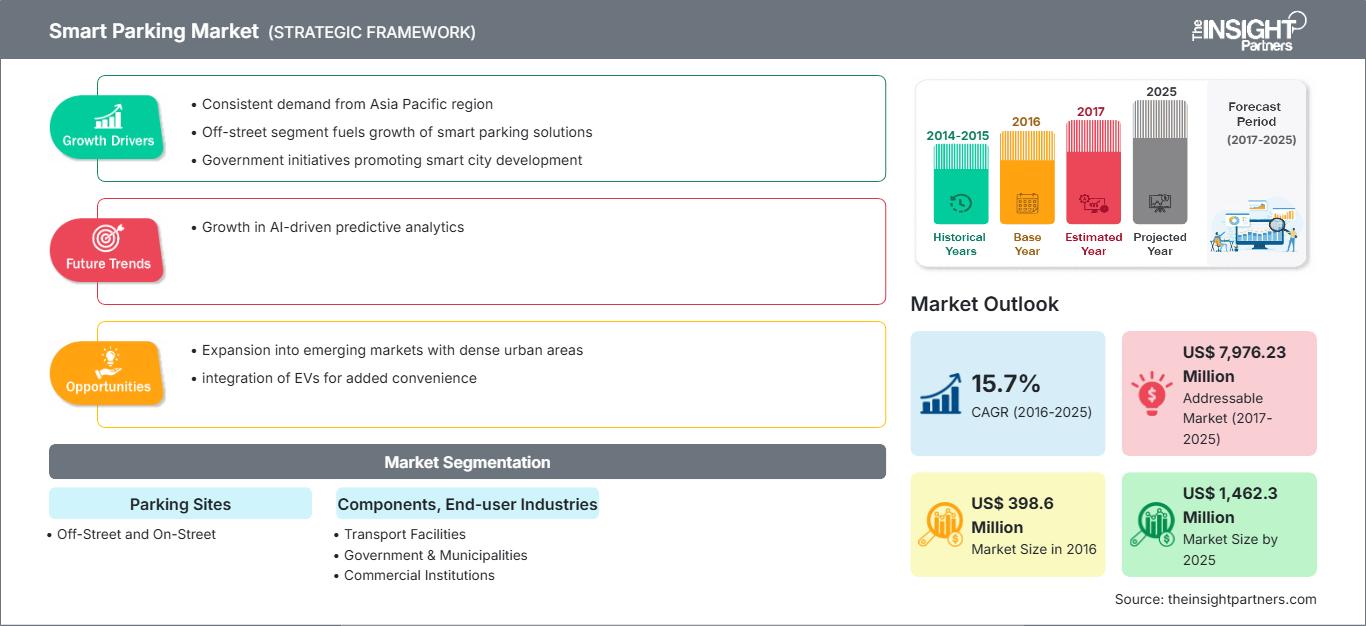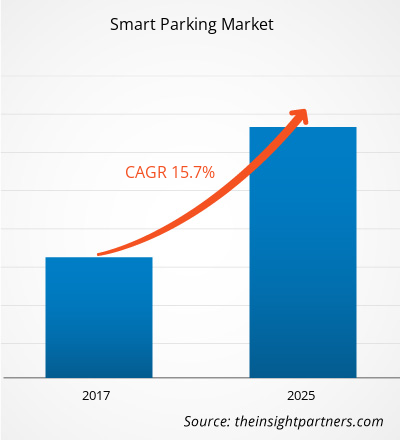Der globale Markt für intelligente Parksysteme wird voraussichtlich von 10,36 Milliarden US-Dollar im Jahr 2025 auf 19,43 Milliarden US-Dollar im Jahr 2034 wachsen, was einer durchschnittlichen jährlichen Wachstumsrate (CAGR) von 10,91 % im Zeitraum 2026–2034 entspricht.
Marktanalyse für intelligentes Parken
Der Markt für intelligentes Parken wächst, da urbane Zentren mit begrenztem Parkplatzangebot und steigenden Fahrzeugzahlen zu kämpfen haben. Intelligente Parksysteme liefern Echtzeit-Verfügbarkeitsdaten, leiten Autofahrer zu freien Plätzen und reduzieren so Suchzeiten, Kraftstoffverbrauch und Staus. Diese Systeme, bestehend aus Sensoren, Kameras, vernetzten Systemen und Softwareplattformen, ermöglichen es Parkraumbetreibern und Kommunen, die Flächennutzung zu optimieren, die Nachfrage zu steuern und sich in umfassendere Smart-City- und Mobilitätskonzepte zu integrieren.
Marktübersicht für intelligentes Parken
Intelligente Parklösungen vereinfachen und automatisieren die Verwaltung von Parkinfrastruktur im öffentlichen Raum und auf Parkplätzen durch dynamische Leitsysteme, Reservierungs-, Zahlungs- und Überwachungsfunktionen. Sie reduzieren den Betriebsaufwand, erhöhen den Nutzerkomfort und unterstützen die Ziele urbaner Mobilität. Ihre Bedeutung wächst mit steigendem Fahrzeugbestand, knapper werdendem Stadtgebiet und der Nachfrage nach kosteneffizienten Parklösungen.
Passen Sie diesen Bericht Ihren Anforderungen an.
Sie erhalten eine kostenlose Anpassung aller Berichte – einschließlich Teilen dieses Berichts, Länderanalysen und Excel-Datenpaketen – sowie attraktive Angebote und Rabatte für Start-ups und Universitäten.
Markt für intelligentes Parken: Strategische Einblicke

-
Ermitteln Sie die wichtigsten Markttrends dieses Berichts.Diese KOSTENLOSE Probe beinhaltet eine Datenanalyse, die von Markttrends bis hin zu Schätzungen und Prognosen reicht.
Markttreiber und Chancen im Bereich Smart Parking
Markttreiber:
- Die zunehmende Verkehrsdichte in den Städten und das steigende Fahrzeugaufkommen erhöhen den Druck auf die Parkinfrastruktur und treiben die Nachfrage nach intelligenteren Parkraummanagementsystemen voran.
- Das Wachstum von Smart-City-Initiativen und der Einsatz des Internets der Dinge (IoT) in urbanen Mobilitätssystemen beschleunigen die Einführung intelligenter Parktechnologien.
- Bedarf an betrieblicher Effizienz und besserer Anlagennutzung seitens der Kommunen und gewerblichen Parkplatzbetreiber.
Marktchancen:
- Expansion in aufstrebenden Märkten mit rascher Urbanisierung, zunehmendem Fahrzeugbesitz und entstehenden Investitionsmöglichkeiten in intelligente Infrastruktur, insbesondere im asiatisch-pazifischen Raum und im Nahen Osten.
- Integration von Parksystemen mit umfassenderen Mobilitäts-, Zahlungs- und Datenanalyseplattformen, wodurch ein Mehrwert geschaffen wird, der über die reine Parkplatzerkennung hinausgeht.
- Die Nachfrage nach Mehrwertdiensten (mobile Reservierungen, dynamische Preisgestaltung, Nutzungsanalysen) eröffnet Parkplatzbetreibern neue Einnahmequellen.
Marktbericht zu intelligenten Parksystemen: Segmentierungsanalyse
Um einen detaillierten Einblick in die Marktstruktur und die Wachstumsaussichten zu erhalten, wird der Markt wie folgt segmentiert:
Am Parkplatz:
- Parken auf der Straße
- Parkplätze abseits der Straße
Nach Komponente:
- Hardware
- Software
- Dienstleistungen
Nach Endverbraucherbranche:
- Transportmöglichkeiten
- Regierung und Kommunen
- Handelsinstitutionen
- Unternehmensinstitutionen
Nach Geographie:
- Nordamerika
- Europa
- Asien-Pazifik
- Süd- und Mittelamerika
- Naher Osten und Afrika
Regionale Einblicke in den Markt für intelligentes Parken
Die regionalen Trends und Einflussfaktoren auf den Markt für intelligentes Parken im gesamten Prognosezeitraum wurden von den Analysten von The Insight Partners ausführlich erläutert. Dieser Abschnitt behandelt außerdem die Marktsegmente und die geografische Verteilung des Marktes für intelligentes Parken in Nordamerika, Europa, Asien-Pazifik, dem Nahen Osten und Afrika sowie Süd- und Mittelamerika.
Berichtsumfang zum Markt für intelligentes Parken
| Berichtattribute | Details |
|---|---|
| Marktgröße im Jahr 2025 | 10,36 Milliarden US-Dollar |
| Marktgröße bis 2034 | 19,43 Milliarden US-Dollar |
| Globale durchschnittliche jährliche Wachstumsrate (2026 - 2034) | 10,91 % |
| Historische Daten | 2021-2024 |
| Prognosezeitraum | 2026–2034 |
| Abgedeckte Segmente |
In der Nähe von Parkplätzen
|
| Abgedeckte Regionen und Länder |
Nordamerika
|
| Marktführer und wichtige Unternehmensprofile |
|
Marktdichte im Bereich intelligenter Parksysteme: Auswirkungen auf die Geschäftsdynamik verstehen
Der Markt für intelligente Parksysteme wächst rasant, angetrieben durch die steigende Nachfrage der Endnutzer. Gründe hierfür sind unter anderem sich wandelnde Verbraucherpräferenzen, technologische Fortschritte und ein wachsendes Bewusstsein für die Vorteile der Produkte. Mit steigender Nachfrage erweitern Unternehmen ihr Angebot, entwickeln innovative Lösungen, um den Kundenbedürfnissen gerecht zu werden, und nutzen neue Trends, was das Marktwachstum zusätzlich beflügelt.

- Verschaffen Sie sich einen Überblick über die wichtigsten Akteure im Markt für intelligentes Parken
Marktanteilsanalyse für intelligentes Parken nach Regionen
-
Nordamerika
- Besitzt einen führenden Anteil am Weltmarkt, was auf eine fortschrittliche Infrastruktur, die frühzeitige Einführung intelligenter Parksysteme und starke kommunale Investitionen zurückzuführen ist.
- Zu den wichtigsten Trends zählen die Verlagerung hin zu Cloud-basierten Lösungen, die Integration mit intelligenten Mobilitätsplattformen und Fahrzeugleitsysteme.
-
Europa
- Ein erheblicher Anteil, der durch die öffentliche Politik, Smart-City-Programme und die hohe Nachfrage nach effizienten Parkmöglichkeiten in großen urbanen Zentren begünstigt wird.
- Es zeichnet sich ein Trend hin zu interoperablen Plattformen und grenzüberschreitendem Datenaustausch ab.
-
Asien-Pazifik
- Es wird erwartet, dass diese Region im Prognosezeitraum das schnellste Wachstum verzeichnen wird, bedingt durch eine beschleunigte Urbanisierung, einen steigenden privaten Fahrzeugbesitz und staatliche Initiativen für intelligente Infrastruktur.
- Chancen für kostengünstige, skalierbare Lösungen in aufstrebenden urbanen Märkten.
-
Süd- und Mittelamerika
- Aufstrebender Markt mit zunehmenden Investitionen in die digitale Infrastruktur; Chancen für cloudbasierte, kosteneffiziente intelligente Parksysteme für öffentliche und private Betreiber.
-
Naher Osten und Afrika
- Entwicklungsregion mit Wachstumspotenzial, angetrieben durch neue Stadtentwicklungsprojekte, Smart-City-Initiativen und die Expansion von Gewerbeimmobilien, die intelligente Parklösungen erfordern.
Marktdichte im Bereich intelligenter Parksysteme: Auswirkungen auf die Geschäftsdynamik verstehen
Der Markt für intelligente Parksysteme zeichnet sich durch eine mittlere bis hohe Anbieterdichte aus, darunter etablierte Technologieunternehmen und spezialisierte Nischenanbieter. Um sich zu differenzieren, konzentrieren sich die Unternehmen auf Folgendes:
- Nahtlose Integration mit Fahrzeugführungssystemen, intelligenter Mobilität und IoT-Netzwerken.
- Skalierbare, cloudbasierte Plattformen, die sowohl für kleine kommunale Programme als auch für große gewerbliche Parkraumbetreiber geeignet sind.
- Analysengestützte Dienstleistungen, die Einblicke in die Nutzung, dynamische Preisgestaltung und Anlagenoptimierung bieten.
- Partnerschaften mit Kommunen, Immobilienentwicklern und Infrastrukturanbietern zur Integration intelligenter Parklösungen in umfassendere städtische Konzepte.
Zu den wichtigsten Unternehmen, die auf dem Markt für intelligentes Parken tätig sind, gehören:
- Amano McGann, Inc.
- Cisco Systems, Inc.
- Smart Parking Ltd.
- Urbiotica
- SKIDATA AG
- Nedap NV
- Kapsch
- Xerox Corp.
- Parkmobile, LLC
Weitere im Rahmen der Studie analysierte Unternehmen:
- TrafficCom AG
- Aisin Corporation
- Continental AG
- Robert Bosch GmbH
- JustPark Parkplätze begrenzt
- INRIX, Inc.
- FlashParking, Inc.
- ParkHelp Technologies
- TKH Group NV
- Cubic Corporation
Neuigkeiten und aktuelle Entwicklungen auf dem Markt für intelligentes Parken
- Die Einführung intelligenter Parklösungen durch Kommunen und Smart-City-Initiativen treibt das Wachstum weiter voran; laut einer Veröffentlichung wird der Markt bis 2025 voraussichtlich ein Volumen von 1,46 Milliarden US-Dollar erreichen.
- Die Integration von Cloud und IoT wird zum Standard; Anbieter von Parksystemen bieten zunehmend sensorgestützte Leitsysteme, mobile Zahlungsmethoden und Analyseplattformen zur Unterstützung des Echtzeit-Parkraummanagements an.
Marktbericht zu intelligenten Parksystemen: Abdeckung und Ergebnisse
Der Bericht „Smart Parking – Marktgröße und Prognose (2021–2034)“ bietet eine detaillierte Analyse, die folgende Bereiche abdeckt:
- Marktgröße und Prognose auf globaler, regionaler und Länderebene für alle wichtigen Segmente, die im Geltungsbereich abgedeckt sind
- Markttrends sowie Marktdynamiken wie Treiber, Hemmnisse und wichtige Chancen
- Detaillierte PEST- und SWOT-Analyse
- Marktanalyse mit Fokus auf wichtige Markttrends, globale und regionale Rahmenbedingungen, Hauptakteure, regulatorische Rahmenbedingungen und aktuelle Marktentwicklungen
- Branchenlandschaft und Wettbewerbsanalyse mit Fokus auf Marktkonzentration, Heatmap-Analyse, führende Akteure und aktuelle Entwicklungen
- Detaillierte Unternehmensprofile
- Historische Analyse (2 Jahre), Basisjahr, Prognose (7 Jahre) mit CAGR
- PEST- und SWOT-Analyse
- Marktgröße Wert/Volumen – Global, Regional, Land
- Branchen- und Wettbewerbslandschaft
- Excel-Datensatz
Erfahrungsberichte
Grund zum Kauf
- Fundierte Entscheidungsfindung
- Marktdynamik verstehen
- Wettbewerbsanalyse
- Kundeneinblicke
- Marktprognosen
- Risikominimierung
- Strategische Planung
- Investitionsbegründung
- Identifizierung neuer Märkte
- Verbesserung von Marketingstrategien
- Steigerung der Betriebseffizienz
- Anpassung an regulatorische Trends






















 Kostenlose Probe anfordern für - Markt für intelligentes Parken
Kostenlose Probe anfordern für - Markt für intelligentes Parken